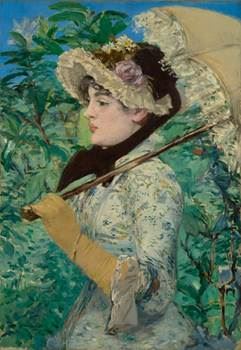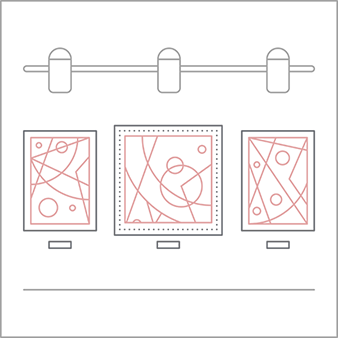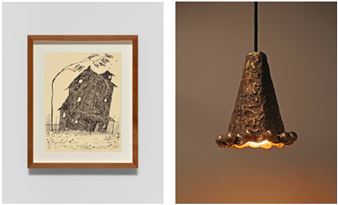Manet and Modern Beauty
ûdouard Manet (1832-1883) is best known today for provocative, large-scale paintings that challenged the old masters and academic tradition and sent shockwaves through the French art world in the early 1860s. In the late 1870s and early 1880s, he shifted his focus and produced a different, though no less radical, body of work: stylish portraits, luscious still lifes, delicate pastels, intimate watercolors, and freely brushed scenes of suburban gardens and Parisian cafes.
On view at the J. Paul Getty Museum October 8, 2019 through January 12, 2020, Manet and Modern Beauty explores for the first time in a major museum exhibition the artistãs last years, after his rise to notoriety in the 1860s and the formal launch of the Impressionist movement in the early 1870s. The exhibition will feature more than 90 works of art, including an impressive array of genre scenes, still lifes, pastels, and portraits of favorite actresses and models, bourgeois women of his acquaintance, his wife, and his male friends.
ãManet is a titan of modern art, but most art historical narratives about his achievement focus on his early and mid-career work,ã says Timothy Potts, director of the J. Paul Getty Museum. ãMany of his later paintings are of extraordinary beauty, executed at the height of his artistic prowessãdespite the fact that he was already afflicted with the illness that would lead to his early death. These works sparkle with an insistent ã perhaps even defiant ã sense of life. Presenting many iconic paintings, including our recently acquired Jeanne (Spring), alongside pastels and intimate watercolors, Manet and Modern Beauty takes a fresh look at this justly renowned and ever-popular artist.ã
Manet died at the age of 51 in 1883, after a long and painful illness. Declining health forced him to adjust his working habits: during the last six or seven years of his life his output was generally more intimate in both scale and subject, focusing on fashionable scenes of Parisian life and the stylish women, and sometimes men, of his acquaintance. Too often dismissed as superficial by critics, these later works provide valuable testimony to Manetãs elegant social circle and suggest a radical new alignment of modern art with fashionable femininity while recording the artistãs unapologetic embrace of beauty and visual pleasure in the face of death.
Manet and Modern Beauty is divided into five sectionsãLa Vie Moderne, Portraits of an Era, The Four Seasons Project, Manet at Bellevue, and Flowers, Fruits, and Gardens. The first of these takes a look at a notable solo show in 1880, when Manet was invited to exhibit in the gallery affiliated with La Vie Moderne, a new fashion and culture magazine. Introducing the public to his provocative cabaret, bar, and boudoir scenes and to his pastel portraits, this exhibition marked a new beginning for Manet. Numerous works shown at the Vie Moderne gallery are on display in this section.

Recommended for you
ûdouard Manet (1832-1883) is best known today for provocative, large-scale paintings that challenged the old masters and academic tradition and sent shockwaves through the French art world in the early 1860s. In the late 1870s and early 1880s, he shifted his focus and produced a different, though no less radical, body of work: stylish portraits, luscious still lifes, delicate pastels, intimate watercolors, and freely brushed scenes of suburban gardens and Parisian cafes.
On view at the J. Paul Getty Museum October 8, 2019 through January 12, 2020, Manet and Modern Beauty explores for the first time in a major museum exhibition the artistãs last years, after his rise to notoriety in the 1860s and the formal launch of the Impressionist movement in the early 1870s. The exhibition will feature more than 90 works of art, including an impressive array of genre scenes, still lifes, pastels, and portraits of favorite actresses and models, bourgeois women of his acquaintance, his wife, and his male friends.
ãManet is a titan of modern art, but most art historical narratives about his achievement focus on his early and mid-career work,ã says Timothy Potts, director of the J. Paul Getty Museum. ãMany of his later paintings are of extraordinary beauty, executed at the height of his artistic prowessãdespite the fact that he was already afflicted with the illness that would lead to his early death. These works sparkle with an insistent ã perhaps even defiant ã sense of life. Presenting many iconic paintings, including our recently acquired Jeanne (Spring), alongside pastels and intimate watercolors, Manet and Modern Beauty takes a fresh look at this justly renowned and ever-popular artist.ã
Manet died at the age of 51 in 1883, after a long and painful illness. Declining health forced him to adjust his working habits: during the last six or seven years of his life his output was generally more intimate in both scale and subject, focusing on fashionable scenes of Parisian life and the stylish women, and sometimes men, of his acquaintance. Too often dismissed as superficial by critics, these later works provide valuable testimony to Manetãs elegant social circle and suggest a radical new alignment of modern art with fashionable femininity while recording the artistãs unapologetic embrace of beauty and visual pleasure in the face of death.
Manet and Modern Beauty is divided into five sectionsãLa Vie Moderne, Portraits of an Era, The Four Seasons Project, Manet at Bellevue, and Flowers, Fruits, and Gardens. The first of these takes a look at a notable solo show in 1880, when Manet was invited to exhibit in the gallery affiliated with La Vie Moderne, a new fashion and culture magazine. Introducing the public to his provocative cabaret, bar, and boudoir scenes and to his pastel portraits, this exhibition marked a new beginning for Manet. Numerous works shown at the Vie Moderne gallery are on display in this section.
Artists on show
Contact details

Related articles
ûdouard Manet (1832ã1883) is best known today for provocative large-scale paintings that challenged the old masters and academic tradition and sent shockwaves through the French art world in the early 1860s.
The exhibition Manet and Modern Beauty celebrates painter ûdouard Manetãs often overlooked final years, when despite his declining health he produced pictures and drawings with a new lightness and brightness of spirit and palette.
The most charming, or at least the cutest, portrait in the Manet exhibition at the Getty Center is the painting of Bob the dog.
The 2019 exhibition calendar was unusually crammed with heavily hyped shows, not to mention floating suspense and sudden combustions of fear and loathing.

 ARTISTS
ARTISTS














